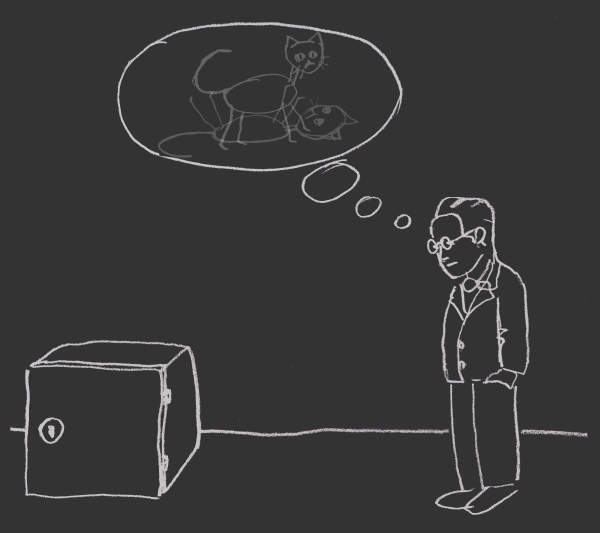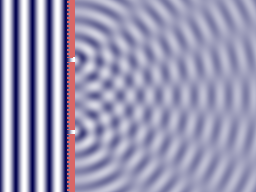| Dietrich Zawischa | Contact | Deutsche Version | |
For a long time I thought that the following composition is redundant, as one may find good explanations in the web. But Schrödinger's cat, though 80 years old by now, resurges too often to its partial life, as there are authors who still claim that quantum physics tells us that a superposition of a live and a dead cat is possible.
Let me expose my point of view without discussing the history of quantum physics and all of its other interpretations in detail. These may be found in the Wikipedia (history, Copenhagen interpretation).
From the paper “Die gegenwärtige Situation in der Quantenmechanik” by Erwin Schrödinger, 1935:
„Man kann auch ganz burleske Fälle konstruieren. Eine Katze wird in eine Stahlkammer gesperrt, zusammen mit folgender Höllenmaschine (die man gegen den direkten Zugriff der Katze sichern muß): in einem Geigerschen Zählrohr befindet sich eine winzige Menge radioaktiver Substanz, so wenig, daß im Laufe einer Stunde vielleicht eines von den Atomen zerfällt, ebenso wahrscheinlich aber auch keines; geschieht es, so spricht das Zählrohr an und betätigt über ein Relais ein Hämmerchen, das ein Kölbchen mit Blausäure zertrümmert. Hat man dieses ganze System eine Stunde lang sich selbst überlassen, so wird man sich sagen, daß die Katze noch lebt, wenn inzwischen kein Atom zerfallen ist. Der erste Atomzerfall würde sie vergiftet haben. Die Psi-Funktion des ganzen Systems würde das so zum Ausdruck bringen, daß in ihr die lebende und die tote Katze (s.v.v.) zu gleichen Teilen gemischt oder verschmiert sind. Das Typische an solchen Fällen ist, daß eine ursprünglich auf den Atombereich beschränkte Unbestimmtheit sich in grobsinnliche Unbestimmtheit umsetzt, die sich dann durch direkte Beobachtung entscheiden läßt. Das hindert uns, in so naiver Weise ein „verwaschenes Modell“ als Abbild der Wirklichkeit gelten zu lassen. An sich enthielte es nichts Unklares oder Widerspruchsvolles. Es ist ein Unterschied zwischen einer verwackelten oder unscharf eingestellten Photographie und einer Aufnahme von Wolken und Nebelschwaden.“
“One may construct quite burlesque situations. A cat is put into a steel box, together with the following infernal machine (which must be shielded from direct attacks by the cat): in a Geiger counter tube there is a minute amount of a radioactive substance, just enough that within one hour maybe one atom decays, or with equal probability no decay occurs; if it happens, the counting tube triggers a small hammer which smashes a vial full of hydrocyanic acid. After leaving this system to itself for one hour, one would say that the cat is alive if no atom decayed in the meantime. The first decay would have poisoned it. The Psi-function of the total system would express this by being a mixture or superposition of equal amounts of the live and the dead cat (pardon my words). The typical feature of such cases is that an uncertainty which was restricted to the atomic scale is transformed to a macroscopic level which then may be observed directly. This prevents us to naively accept a “blurred model” as a representation of reality. Per se it would not contain anything obscure or contradictory. There is a difference between a shaky or out-of-focus photograph and an image of clouds or wafts of mist.”

According to the Copenhagen interpretation, by measuring an observer causes the wave function to “collapse” to a new state which is compatible with the result of the measurement.
Sometimes even nowadays one can read that quantum theory says that the collapse is due to conscious perception of the result by an observer. As an example a quotation: Hans Christian von Baeyer “Quantum Weirdness? It's All in Your Mind.”, Scientific American, Volume 308, Issue 6, 2013:
“Now run the experiment—but don't look inside the box. After an hour has gone by, traditional quantum theory would hold that the atom's wave function is in a superposition of two states–decayed and not decayed. But because you haven't yet observed what is inside the box, the superposition extends further. The hammer is also in a superposition, as is the vial of poison. And most grotesquely, the standard quantum-mechanical formalism implies that the cat is in a superposition—it is both alive and dead at the same time.”
Libel and slander? The tacit understanding seems to be that a macroscopic system, even one with a live cat, is describable by a wave function.

Diffraction by a double slit
A plane wave coming in from the left falls on an absorbing screen with two narrow slits. The outgoing waves on the right show alternating constructive and destructive interference. Double-click on the picture will switch on the animation, a single click switches it off again.
The weird feature of quantum physics is that particles also behave like waves, so that interference phenomena may occur. The theoretically simplest and most discussed example is diffraction of particles, e.g. electrons, in a double-slit experiment. An electron moves like a wave simultaneously through both slits, but at the detector (photographic film) it manifests itself as a particle with its full charge concentrated in one point. To see interference fringes, many electrons must be sent through the two slits, and for all of them holds that their waves arriving at the detector contain the same fringe pattern. This means that for all electrons, the phase difference of the wavelet coming from slit 1 and the other one coming from slit 2 is the same.
The time-dependence of a quantum state with energy E is given by the factor e–i(ωt+φ), with ω=2πE/h and h the Planck constant, φ is a phase which is not observable.
While an atom, a molecule or another quantum mechanical system may stay for a long time in an energy eigenstate with the phase φ staying constant, this is not possible for a macroscopic system. Macroscopic states are never energy eigenstates, but rather superpositions of very many states with only nearly the same energy. Moreover, every photon which is absorbed, every quantum of thermal radiation which is emitted, every gas molecule which impinges changes the energy, so that the system goes through unimaginably many different states while we glance at it. Clearly, there is no constant phase of the macrostate.
For observable effects (e.g. interference fringes) of a superposition of states it is necessary that there is a definite phase relation between them.
Now consider one of the decaying nuclei which can emit an α-particle. If there were only this nucleus, its state would be a superposition of |parent nucleus> and |daughter nucleus + α-particle>, the α-particle being represented by an outgoing spherical wave. But the nucleus is supposed to have its electron shells and to be in a Geiger counting tube. The tube is filled with gas and has the temperature of the surroundings, clearly this is a macroscopic system. As soon as the outgoing α-particle ionizes one of the gas molecules, its wave function looses its sperical symmetry and collapses, and with each following ionization it collapses anew to a small vicinity of the newly ionized molecule.
The ions and the electrons are accelerated by the electric field in the counting tube, collisions ionize more molecules and an ionization avalanche leads to an electric pulse through the relay—with fatal consequences for the cat.
It is the measurement which causes the reduction of the wave function to one compatible with the measured value. But by now it should be clear that this is caused by the interaction with the measuring apparatus and is independent of the observer's attention or knowledge.
Up to now, there are no experiments which contradict the standard Copenhagen interpretation.